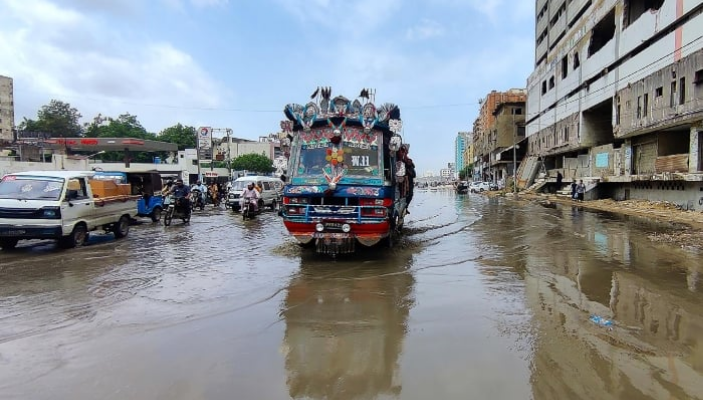Karachi, Pakistan’s largest city and economic hub, experiences a unique blend of weather conditions throughout the year. Its climate is largely classified as hot desert, but the city’s proximity to the Arabian Sea adds layers of humidity, sea breeze influence, and monsoon behavior that make the weather feel quite different from typical desert environments.
This article explains Karachi’s weather in a way that’s helpful, original, and grounded in real-world experiences of those who live and work here—whether you’re planning your daily commute, a weekend outing, or just staying safe during extreme conditions.
Understanding Karachi’s Year-Round Climate Pattern
Karachi does not have the distinct four seasons typically associated with temperate climates. Instead, it primarily experiences:
- Hot season (April–June)
- Monsoon/rainy season (July–September)
- Mild winter (December–February)
- Transition periods (March and October-November)
1. Summer (April to June)
Temperatures often climb above 40°C (104°F), but what makes Karachi’s summer particularly uncomfortable is the persistent humidity. Despite the intense sunlight, the presence of sea breeze can bring temporary relief, especially in coastal neighborhoods.
Key summer observations:
- Heat index is higher than actual temperature
- Frequent power outages affect comfort levels
- Risk of heatstroke and dehydration if exposed outdoors for long
Humidity and Heat Index: The Real Challenge
Many weather apps may show Karachi at 34°C, but when you factor in humidity levels ranging between 60–85%, it feels like 42–45°C. This difference—known as the heat index—can be dangerous for sensitive individuals, including the elderly and children.
Humidity in Karachi doesn’t just make the heat feel worse; it also affects:
- Breathing comfort
- Skin conditions
- Efficiency of fans and air-cooling appliances
Monsoon Season: Rain with Urban Consequences
Monsoon arrives between mid-July and early September. It brings brief but intense spells of rainfall, often within a span of just a few hours. Due to poor drainage infrastructure, these rains can lead to:
- Urban flooding in low-lying areas
- Traffic gridlocks lasting hours
- Overflowing stormwater drains and sewage backups
Even a single inch of rain can severely impact city life, especially in neighborhoods like Saddar, Gulshan-e-Iqbal, and North Karachi.
Monsoon-specific tips:
- Check hourly weather forecasts before commuting
- Avoid traveling through underpasses and poorly lit roads
- Stock up on essentials before expected heavy rainfall
Karachi’s Sea Breeze: A Natural Air Conditioner?
From the west, the sea breeze regularly makes its way inland in the afternoons. This phenomenon is most noticeable from March to November. Though it moderates temperatures slightly, air quality and dust levels often remain a concern—especially when dry winds from the north clash with the moisture-rich sea breeze.
Sea breeze timing typically ranges from 12 PM to 6 PM, peaking in strength between 2 PM to 4 PM.
Winter in Karachi: A Short-Lived Comfort
Karachi winters, lasting from December to February, offer a break from the oppressive summer. Average low temperatures range between 12–18°C (54–64°F), with daytime highs rarely exceeding 26–28°C (78–82°F).
Notable winter effects:
- More foggy mornings in suburban and industrial areas
- Slight rise in respiratory issues due to cold and pollution
- Popular time for outdoor weddings, shopping festivals, and beach visits
Although mild by international standards, the lack of indoor heating systems can make winter nights feel colder than the numbers suggest.
Karachi Weather Apps vs. Actual Experience
Residents often report that forecasted temperatures feel significantly different from what they experience outside. This is primarily due to:
- Microclimates within different parts of the city
- Varying wind speeds and sun exposure
- Buildings and concrete contributing to urban heat island effect
For example, while DHA or Clifton may experience strong sea breeze and slightly lower temperatures, interior locations like Landhi or Korangi may remain hot, humid, and windless.
Air Quality and Weather: The Overlooked Link
While not part of weather forecasts, air quality is an emerging concern for Karachiites. During winters and dry months (particularly October and March), PM2.5 and PM10 levels spike due to:
- Construction dust
- Vehicle emissions
- Industrial smoke
- Low wind speeds trapping pollutants
Weather changes like a sudden drop in temperature or a dry northwesterly wind can sharply increase smog in certain areas.
Emergency Weather Alerts & Preparedness
The Pakistan Meteorological Department (PMD) regularly issues advisories about:
- Heatwaves
- Heavy rainfall risks
- Coastal storms or cyclones
It’s wise to keep notifications enabled for your preferred weather app or follow official Twitter handles and SMS alert services.
Key safety steps:
- Never leave home during red-alert rainfall warnings
- Keep a portable charger, bottled water, and essential medicines ready
- For heatwaves, avoid going out between 12 PM–4 PM
How Weather Affects Daily Life in Karachi
Weather influences everything from clothing and food to power usage and public mood. During summers, consumption of cold drinks and fresh juices spikes, while in winter, tea stalls and soup vendors do brisk business.
Public behavior shifts:
- Summer evenings draw crowds to beaches, parks, and open-air malls
- In rainy weather, online shopping and food delivery services see a rise
- Mild winters bring open-air concerts, book fairs, and cricket matches
Final Thoughts: Why Karachi Weather Matters
Karachi’s weather is more than just a number on your screen—it affects how the city moves, breathes, and survives. Understanding the layers of humidity, seasonal winds, rainfall, and heat index empowers residents to better plan their days and protect their health.
By staying weather-aware, Karachiites can adapt to climate extremes, enjoy seasonal perks, and minimize the risks posed by an increasingly unpredictable climate.
